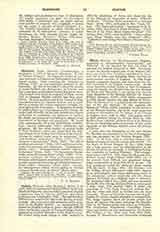

Clifton, Diocese of (CLIFTONIENSIS), England, consisting of Gloucestershire, Somersetshire, and Wiltshire. It was founded by Pius IX when he restored the English hierarchy in 1850. Previously to that the diocese formed part of the Western District, one of the four vicariates established by Innocent XI in 1688, and including Wales and the six southwestern counties of England. In 1840 Wales became a separate vicariate, and thenceforth the district consisted of the English counties only. As the vicars Apostolic resided chiefly at Bath in Somerset, when the district was divided into the two dioceses of Clifton and Plymouth, it was fitting that the last Vicar Apostolic of the Western District, Dr. Joseph William Hendren, O.S.F. (1791-1866), consecrated in 1848, should become the first Bishop of Clifton. Thus the diocese is, in a special sense, the representative of the old vicariate. In this capacity the Bishop of Clifton retains possession of the archives of the Western District, one of the most important sources of information for the history of the Church in England from 1780 to 1850. The papers earlier in date perished during the Gordon Riots in 1780. Besides these valuable archives there is at Bishop‘s House an interesting series of portraits of the vicars Apostolic of the Western District and of the bishops of Clifton.
A year after the foundation of the new diocese Dr. Hendren was translated to the See of Nottingham and was succeeded by Dr. Thomas Burgess (1791-1854). On June 28, 1852, a cathedral chapter, consisting of a provost and ten canons, was erected. On the death of Bishop Burgess, November 27, 1854, there was a long vacancy, and the administration of the diocese was given provisionally to Archbishop Errington, coadjutor to Cardinal Wiseman. This arrangement lasted until February, 1857, when the Hon. and Rev. William Joseph Hugh Clifford (1823-1893), son of the seventh Lord Clifford, was appointed bishop, being consecrated by Pope Pius IX in person. His long pontificate lasted for thirty-six years, ending with his death, August 14, 1893. His successor was Dr. William Robert Brownlow (1836-1901), famous as an archaeologist, and whose well-known work on the catacombs, written conjointly with Dr. James Spencer Northcote, is a classical work of reference. Dr. Brownlow died November 9, 1901, and was succeeded by the Rt. Rev. George Ambrose Burton, consecrated May 1, 1902. The diocese, which is under the patronage of “Our Lady Conceived without Sin” and Sts. Peter and Paul, is divided into six rural deaneries. There are 57 public churches and chapels, besides 24 private chapels belonging to communities.
The clergy number about 50 secular priests and about 80 regulars, the latter including the Benedictines of the famous abbey and school at Downside. The Dominicans, Franciscans, Carmelites, Cistercians, and Jesuits are also represented in the diocese. The College of Sts. Peter and Paul, Prior Park, founded by Benedictines and afterwards conducted by secular priests, is now in the hands of the Fathers but was now calm, joyous, and smiling. She walked of the Society of the Holy Ghost barefooted to the tollbooth on Ousebridge, for she Catholic Directories (1850-1907); BRADY, Annals of the had sent her hose and shoes to her daughter Anne, in Catholic Hierarchy (1877) token that she should follow in her steps. She had been tormented by the ministers and even now was urged to confess her crimes. “No, no, Mr. Sheriff, I die for the love of my Lord Jesus”, she answered. She was laid on the ground, a sharp stone beneath her back, her hands stretched out in the form of a cross and bound to two posts. Then a door was placed upon her, which was weighted down till she was crushed to death. Her last words during an agony of fifteen minutes, were “Jesu! Jesu! Jesu! have mercy on me!” Her right hand is preserved at St. Mary’s Convent, York, but the resting-place of her sacred body is not known. Her sons Henry and William became priests, and her daughter Anne a nun at St. Ursula’s, Louvain. Her life, written by her confessor, John Mush, exists in two versions. The earlier has been edited by Father John Morris, S.J., in his “Troubles of our Catholic Forefathers”, third series (London, 1877). The later MS., now at York Convent, was published by W. Nicholson, of Thelwall Hall, Cheshire (London, Derby, 1849), with portrait: “Life and Death of Margaret Clitherow the martyr of York”. It also contains the “History of Mrs. Margaret Ward and Mrs. Anne Line, martyrs”.
BEDE CAMM

